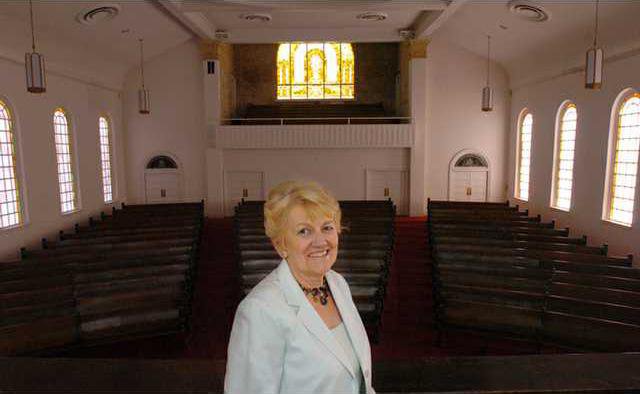One of the oldest churches in Gainesville, which stands on the corner of Green and Academy streets, is also an architectural gem, according to Gainesville architect Garland Reynolds.
"The brickwork is exceptionally fine on that building because the mortar joints are very small," Reynolds said. "People who laid that brick knew what they were doing. We don’t lay brick that tight any more."
The building is framed in marble, which also makes it unique, he said.
"It is trimmed in white Georgia marble, which was very trendy at the time and it was readily available from over in Tate," Reynolds added.
The Methodist Church, which began construction in 1906, was completed in 1908 and the congregation remained there until 1985 when the new First United Methodist Church opened on Thompson Bridge Road, according to a history provided by the First United Methodist Church in Gainesville.
The church, with all of its architectural beauty, is now owned by The Arts Council Inc. and is used for rentals, concerts and performances.
"It was gifted to us around 2002 then we have enjoyed a couple affiliates in here," said Gladys Wyant, executive director of The Arts Council. "What we have used it as incubator space, people outgrow the space. We don’t ever see this being a church again, it’s just for rentals."
Wyant views the building as a special space that The Arts Council one day will use frequently for weddings and other events.
"One thing I like as far as a performing arts setting is that the floor is raked," she said. "The pews are the original pew and we have debated whether to take the pews out and put in theater seating or leave the pews ... with theater seats we would lose a lot of seating. Eventually we will put cushions in them so they will be more comfortable."
Reynolds describes the building as Romanesque Revival which became popular around the 1880s.
"It’s not pure but it is an adaptation," he said. "It’s signified by round arches instead of pointed arches and a lot of brick detailing around the arches."
Other original details include stained glass windows, large and small, all around the church. A large dome in the ceiling of the sanctuary has a stained glass piece anchoring in the center. Columns and thick pine beams run across the sanctuary ceiling.
"The beams that go across here are heart pine," Wyant said. "They are not steel. They would have to have a whole tree; the quality of the structure is phenomenal ... the dome is a nice feature that you don’t see in a lot of churches."
But Reynolds said if had been up to him the dome wouldn’t have been added to the building.
"Actually I would have never have done it because it would be deadly for acoustics ... the sound gets up there and bounces around and does weird things," he said.
A feature that Reynolds thinks is astounding is the parsonage, where the minister would reside, that is connected to the church sanctuary.
"It is more interesting architecturally than the church because it is a prairie style," he said. "Prairie style came out of Chicago; Frank Lloyd Wright was one of the first users of prairie style. You can tell what it is by several things: the brick work, the banding, some of the brick detail where it looks like there are ribbons around it ... it is typified by a flat soffit."
The complex is one of just a few buildings that survived the tornado to hit downtown Gainesville in 1936. One other surviving structure is the old downtown train depot, The Smithgall Arts Center, also owned by The Arts Council, according to Wyant.
"After the tornado it was used as an infirmary in addition to the church," Wyant said.
The church, which also has housed the Westminster Presbyterian Church, has undergone $800,000 worth of renovations; improvements are continuing.
"The improvements are a lot of the things that you can’t see," Wyant said. "We have some water damage in here ... as a matter of fact, in the next week or so we are going to be addressing that more."
Wyant said plans for renovating inside the church include removing the plaster on the walls to expose the brick underneath. The building is actually five layers of brick, Wyant said.
"There is no insulation; the brick is the insulator, if you will, and (removing the plaster) would take it back to the original."
The heating and air conditioning systems have all been replaced, along with the roof.
"Since we have some down time in here we are going to start doing more of the aesthetics," Wyant said. "We want to make sure we finish repairing the water damage before we spend any more money."

